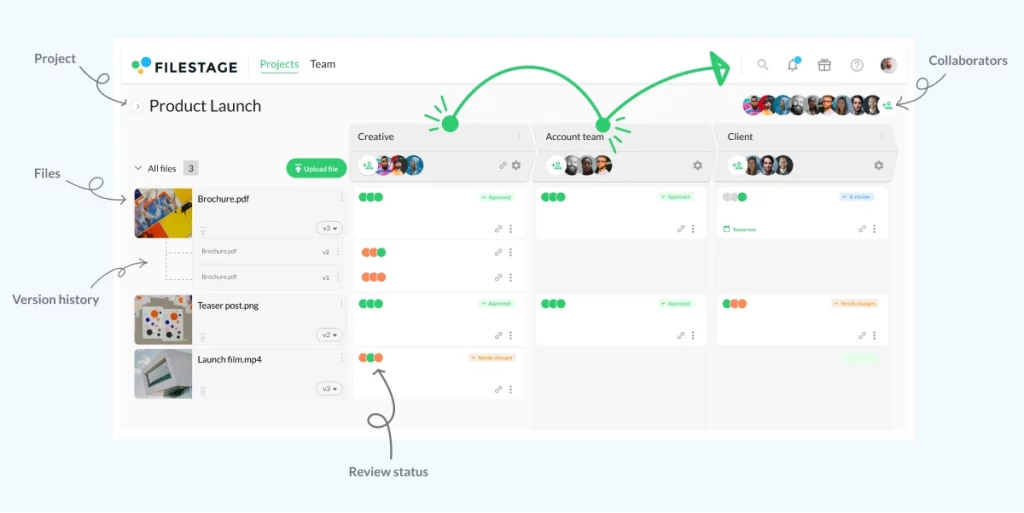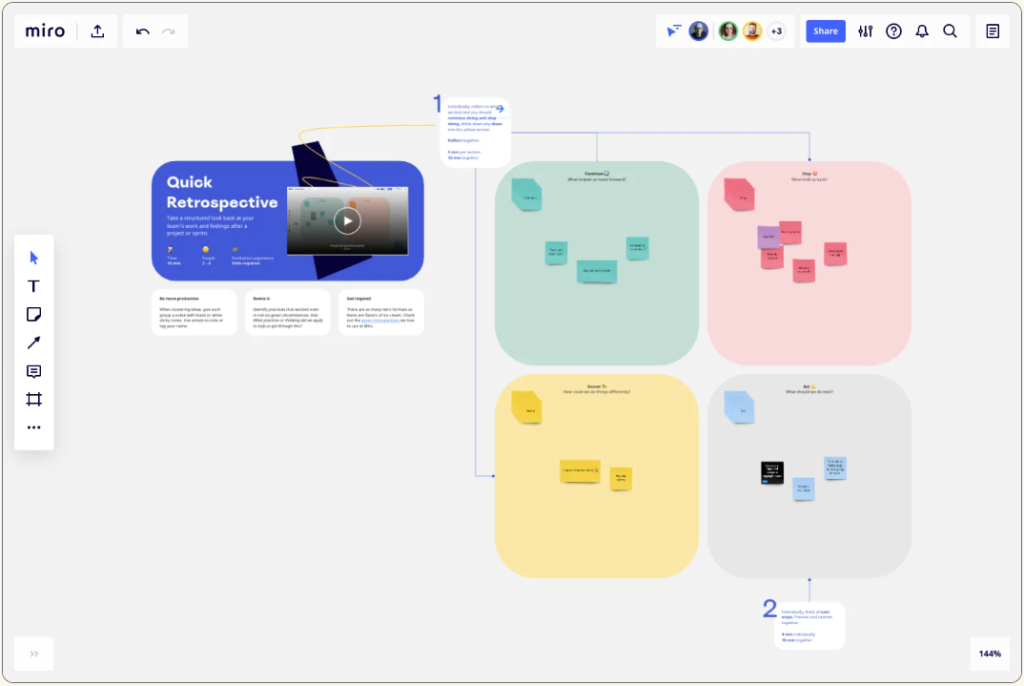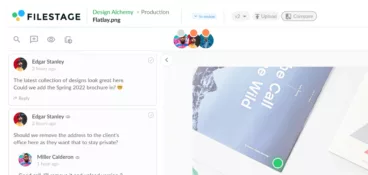Client communication refers to the tools and processes you use to collaborate with clients as a service provider.
If you want to run a sustainable agency or freelance business, you need to hold onto your clients for as long as possible. And for that, you need to become an expert at client communication.
Here’s why.
For ad agencies in the US, pitching for new business costs $204,461 on average. But brands and clients can be fickle. A few years ago, a study published by AdAge revealed that 38% of US brands are likely to get rid of their ad agency within the next six months. Ouch!
Freelancers: “But what about us?” Well, for freelancers, the problem is competition.
Upwork’s annual “Freelancing in America” study shows that the number of freelancers in the US has risen from 57 million in 2019 to 64 million in 2023. And with more platforms and recruiters popping up every day, finding top talent is easier than ever – which only makes holding onto clients harder!
So whether it’s the cost of winning new business or the competition of other freelancers, your client communication needs to be on point if you want to sustain and grow your business.
Over the last 10+ years, I’ve been an ad agency creative, a freelance copywriter, and a client hiring other agencies and freelancers. I’ve seen poor client communication from every angle and learned a hell of a lot along the way.
So, without further ado, here are my nine client communication best practices to help you boost client retention.
1. Get to know your client’s wider business goals to maximize your value
The best agencies and freelancers are far more than just doers. They’re strategic partners who chip in at every opportunity to help make their client’s business a success.
So when you’re onboarding a new client or pitching for a new piece of business, ask questions that show you’re thinking about the big picture.
Here are some examples:
- What are your company’s long-term goals over the next 3-5 years?
- What are your company’s short-term goals over the next couple of quarters?
- What do you see as the most promising channels to help you achieve your goals?
- Which channels have you tried and failed to grow in the past?
- What competitors do you look at and think: they’re the ones we need to beat?
Asking these kinds of questions has two major benefits. First, it shows your customers that you care about their business. But, better than that, it helps you understand client expectations at a higher level so you can spot areas where you can add more value.
2. Invite clients to your collaboration tools for more effective client communication
If you want to enjoy effective communication and maintain strong client relationships (which you absolutely do!), then team communication tools are a must.
After all, email is the devil, let’s be honest. And don’t even get me started on phone calls and meetings.
Back in the day, you could only use communication and collaboration tools with other people at your company. But today there are a whole host of tools that let you invite guest collaborators and clients into the mix.
In my experience, here are three of the most effective client communication tools:
- Asana – Set up separate projects for each of your clients, then invite clients to the specific projects that are relevant to them. This makes it easy for people on the client’s team to track progress without the need for meetings or regular status updates.
- Slack – Create dedicated channels for each client, then invite your client’s team to join. These channels are the perfect place for posting inspiration, collecting key assets, or sharing review links for feedback and approval (more on that below!).
- Filestage – Set up consistent workflows to get your content and creative assets from v1 to approved. Use reviewer groups to separate internal and client feedback, and set up integrations to keep everyone up to date in your favorite tools.

3. Give context when sharing work to anticipate questions and demonstrate expertise
One common mistake agencies and freelancers make is that they think their project is the only one their client is managing. But that’s just not the case.
At any given time, your client could be managing:
- New product launches (and everything that comes with them)
- Out of home ads
- Social content
- Email marketing
- PR campaigns
- A website redesign
- Influencer marketing
- The list goes on …
So when it’s time to share those campaign ideas or designs you’ve been working on, give plenty of context.
Loom is my go-to client business communication software for this. Instead of simply sharing your work, you can recap the brief and guide clients through your process before showing your idea, design, copy – whatever!

This has several important benefits that will improve your client relationships:
- It reminds clients what you’re trying to achieve, avoiding unnecessary back and forth
- It shows other avenues you explored and why you abandoned them, minimizing the chances of feedback that takes you back to the drawing board
- It highlights the research, insights, and references that inspired your work, showing all the effort that went in behind the scenes
- It helps you manage client expectations about the next steps for your project
4. Be the driving force that makes sure your clients hit their deadlines
If there’s one thing that puts clients under pressure at work, it’s missing deadlines.
Brands pour huge amounts of money into their marketing campaigns. And as launch dates approach, clients have to juggle agencies, media companies, and internal stakeholders all at once.
Now, look at things from your client’s perspective. Do you want an agency you have to constantly chase for updates? Do you want to work with a team without a clear plan? And do you want to work with people whose written communication is impossible to follow?
Of course you don’t!
You want an agency that can communicate effectively to drive the campaign for you. One that tells you when the work will be delivered before you have to ask – and then delivers it earlier than expected anyway. And one that tells you when they need your feedback to keep things moving forward.
Speaking of …
5. Give clients a fast and collaborative way to share feedback on your work
For agencies and freelancers, the feedback and approval process is one of the biggest strains on client communication.
Here’s why: the experience of giving feedback over email sucks.
The email and the work your client is reviewing are in separate windows. So they have to take screenshots, type out timecodes, and send long-winded descriptions to make sure you have enough context. And all that stuff takes time and effort.
You could take the verbal communication approach with meetings and phone calls. But if you really want to give your clients a better experience during the approval process, you should consider using a client feedback tool like Filestage.
Filestage is a tool that lets you share files, collect feedback, and track approvals on your projects. This centralizes all your client communications during the review process, and it makes the process a million times better for you and them.
Here’s how:
- Clients can click directly on videos and designs to add comments
- Annotation tools let clients draw lines, boxes, and arrows to give comments more context
- You and your clients can reply to each other’s comments to keep everything in one place
- When you set due dates, clients get automated reminders to help them give feedback on time
- When clients are done giving feedback, they can click “Request changes” or “Approve” to share their review decision with you
- New versions can be shared and compared alongside old ones, with smart features to highlight what’s changed
Want to see Filestage in action? Start a free trial today.
Supercharge your client collaboration
Share, review, and approve all your content in one place with Filestage.
6. Run washups and retrospectives to improve your collaboration with every project
Every company has different challenges and ways of working. So on your first couple of projects, it’s perfectly normal for there to be hiccups. The key is to learn from them.
But here’s the thing. Clients aren’t always forthcoming with feedback, criticisms, and suggestions for new ways of working. They may just assume you’re a bad fit and quietly start looking elsewhere.
So if you want to build long-lasting relationships and support open client communication, you need to give them a forum to share how they really feel.
Project washups and retrospectives (or retros) are perfect for this. Using a tool like FigJam or Miro, you can run a structured post-it session that helps to surface any friction or frustrations that you can improve on next time. And this is also a good opportunity to give your clients feedback too.

Here are some helpful questions and prompts you could include:
- What challenges did we face during the project?
- Were there any unexpected issues or surprises?
- How effective was our communication during the project?
- Is there anything we could have done to help you communicate the project internally?
7. Give plenty of notice about vacations and other absences
This is a nice quick one.
If you’re going away on vacation or taking time off, it’s always a good idea to let your clients know about it.
Depending on the length of your trip, I’d suggest giving anywhere from one to four weeks’ notice. You may already have a notice period agreed in your contract, so be sure to check that to be safe!
As well as sending out a client communication to give them notice, I would also recommend:
- Pointing them towards another teammate if something important comes up
- Setting an out of office on your email and collaboration tools
If you’re vital to the project’s delivery, you may also want to give them your contact number in case of emergencies. Your call!
8. Document and organize everything so clients can always find what they need
When you misplace files at work, it can take hours to track them down again.
It isn’t in your downloads.
You can’t find it in your inbox.
Teams? Nope.
Trello? Nothing.
And before you know it, you’re wondering if you dreamed the whole thing.
This isn’t an experience you want to put your clients through – it’s a frustrating slow-down that they can do without. And so can you. After all, you’ll be the one they’re emailing to track down the files they need.
Here are a few ways you can get more organized to improve your client communication:
- Set up a shared drive for each client with a clear folder structure for all your files
- Follow document version control best practices to help clients identify the latest versions of your content
- Include context and descriptions when sharing links on chat in case clients need to search for them later
- Use project management software so clients can easily find documents and assets relating to your tasks
- Use approval software to centralize feedback, change requests, and approvals
And, if you really want to form a relationship that lasts, you could create a resource center in Notion. This gives you somewhere to save things like creative inspiration, campaign results, and processes – perfect for onboarding new team members or clients.

9. Celebrate your wins and be transparent about challenges
One of the most common ways agencies and freelancers try to improve client communication is by celebrating their wins.
This includes things like:
- Beating your client’s average open rate on an email campaign
- Hitting a follower or engagement milestone on social media
- Getting positive comments on your latest ad on YouTube
By shining a light on all the good stuff, teams try to set a positive tone for client communications. And while this is a great and useful trick to have up your sleeve, it doesn’t mean you should hide from your challenges.
Bad news always has a way of coming out eventually. So don’t mask it. Don’t hide it. Be forthcoming with any problems you’re facing (even if you’ve caused them) and show your clients how you plan on solving them. I promise they’ll thank you for it.
Final thoughts
Thank you for taking the time to read my tips on effective client communication and retention.
From agreeing on your communication channels to being transparent about your challenges, you now have everything you need to roll out a better client communication strategy for your business.
As well as walking you through my best practices, I’ve also introduced you to my favorite client communication software for the job – one of which is Filestage.
If you’d like to see how Filestage can improve client feedback process, start a free trial today →









